Historic Fort Worth, Inc. Fights to Save FWISD Properties
Many have wanted to know Historic Fort Worth, Inc’s (HFW) position concerning the FWISD’s plans to sell 18 properties. Because education is a key component of HFW’s mission, this document is a response to questions from HFW members and serves to inform our followers about the significance of Farrington Field, the Boulevard Heights Transition Center, and the Jack A. Billingsley Field House. Additionally, we have included the economic incentives that can help with the rehab expenses of these buildings and structures that contribute to the unique historic identity of Fort Worth, Texas.
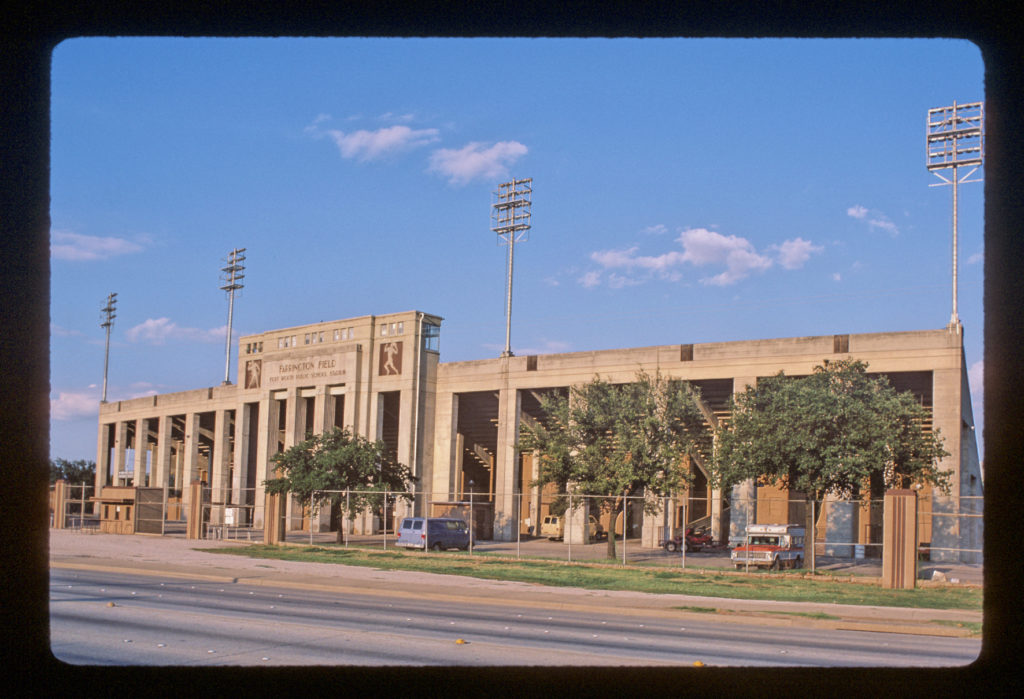
Photo courtesy of Historic Fort Worth, Inc.
Fort Worth has the greatest collection of historic buildings, schools, bridges and structures in this region of Texas; but we are losing them at an alarming rate. As the most influential youth educator in the city, and as the owner of the largest collection of historic grade school buildings of any public or private institution in Fort Worth, we look to the trustees of the FWISD to care for their enviable collection of historic buildings. Now is the time for the FWISD to serve as the next generation’s stewardship leader of the built environment.
Stewardship includes understanding how to care for what is irreplaceable. It respects the conservation of rare building materials, validates timeless construction methods, develops a keen understanding of scale, decreases what goes into our landfills, and ultimately, instills respect for those unique places that are associated with key architects, buildings, city founders and leaders that define Fort Worth.
Of the properties the FWISD plans to sell, Historic Fort Worth, Inc. has identified three historically-significant resources without designation protection, two of which are clearly in a development zone and one that represents three distinct buildings constructed at different time periods that were ultimately combined into one building. Collectively, they have been part of our city for 70-100 years, and they deserve a future in it. It is up to this group of FWISD trustees to protect those historic buildings and structures that earlier trustees prioritized and had designed and built by the best architects and construction firms of the day. Below is how:
Step one in protecting what is irreplaceable is for the FWISD to complete the City of Fort Worth’s application to landmark their most iconic buildings before they are altered or sold. Easily qualifying as City of Fort Worth Historic and Cultural Landmarks are Farrington Field, Billingsley Field House, and Boulevard Heights Transition Center, which is comprised of three historic buildings. This designation status comes with a 10 year property valuation freeze on the city’s portion of an entity’s property tax bill, and that economic incentive “runs” with the land. https://fortworthtexas.gov/developmentservices/permits/pdf/Historic-Designation.pdf https://fortworthtexas.gov/developmentservices/historic-preservation/tax-exemption/
Step two is to complete the application to designate these resources as Recorded Texas Historic Landmarks or place them on the National Register of Historic Places. The state and national designations generate rehabilitation tax credits for non-profit and for-profit owners to sell at 25 cents for every dollar spent on an appropriate improvement project. In certain deals, the National Register designation would generate another 20 cents for every restoration dollar spent. https://www.thc.texas.gov/preserve/projects-and-programs/preservation-tax-incentives
Designation-Worthy Properties Owned by the FWISD
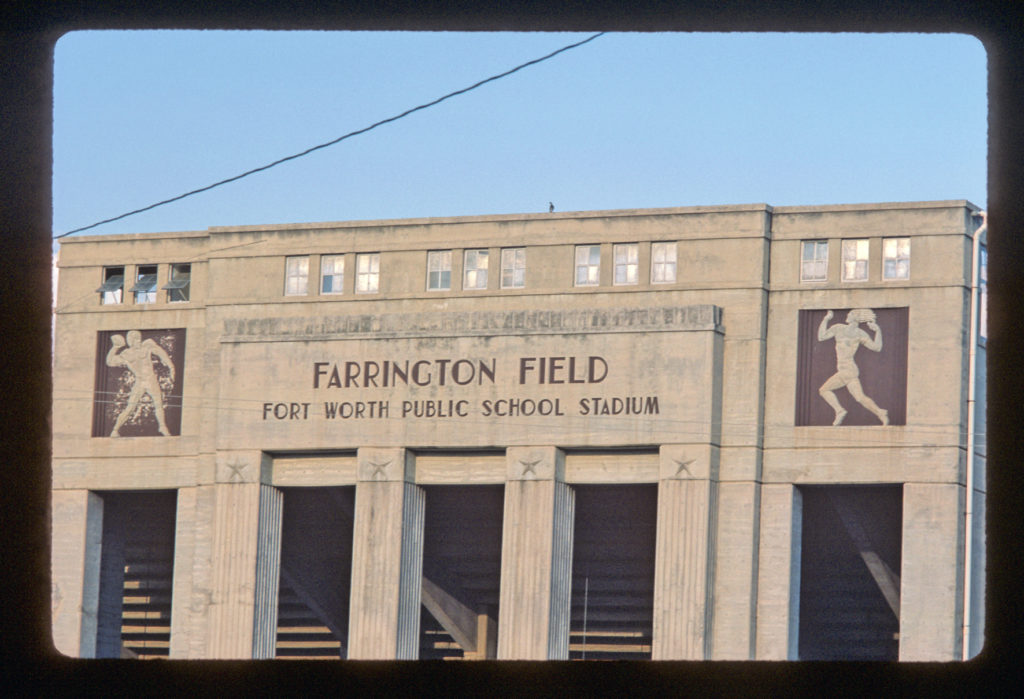
Photo courtesy of Historic Fort Worth, Inc.
Farrington Field:
On HFW’s Most Endangered List 5 times
Address: 1501 University Drive
Date built: 1939
Farrington Field is a beloved and popular stadium and it is Fort Worth’s only remaining historic, Art Deco stadium. Built as a Depression-era relief project that employed about 500 workers, Preston M. Geren served as the consulting architect for this Classical-Moderne stadium with fluted piers, star capitals and bas-relief panels of athletic figures designed by Fort Worth artist Evaline Sellors.
The well-maintained Farrington Field is vulnerable without local designation protection especially with the dense, new development from Lancaster Avenue to White Settlement Road, and rising property values. The Board of Historic Fort Worth, Inc. included it on its endangered list five times…2008, 2009, 2010, 2011 and 2012. The citizens of Fort Worth and the FWISD would be well-served if Farrington Field were designated as an Historic & Cultural Landmark of the City of Fort Worth and placed on the National Register of Historic Places.
Boulevard Heights Transition Center: (Comprised of three buildings)
Former names: Arlington Heights Elementary School, Arlington Heights Public School, Arlington Heights Junior High School, Arlington Heights High School
Address: 5100 El Campo Avenue
Dates built: 1909, 1922, & 1954
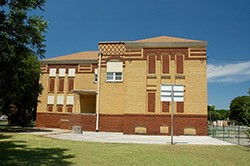
Photo courtesy of Historic Fort Worth, Inc.
The oldest building of the three on the site is closest to Camp Bowie Boulevard and was constructed in 1909 by the Arlington Heights ISD. It was designed by Sanguinet & Staats in the shape of a “T”. The facade features two colors of brick — a yellow brick with a maroon brick used at the base — in bands, and with a decorative pattern at various locations. A combination of arched and rectangular openings is used for the school’s windows and doors. Many of the windows have been infilled with panels or brick.
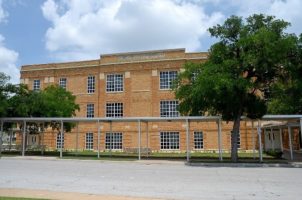
Photo courtesy of Historic Fort Worth, Inc.
The second of the three buildings was built in 1922 as the first Arlington Heights High School. Its address was 5100 Camp Bowie Boulevard as El Campo Avenue did not yet extend in front of the campus as it does now. It served as a high school until 1927 when W.C. Stripling High School was constructed, then it became a junior high school, and in 1954 an elementary school. The building has brick pilasters between the basement and the cornice, with tall windows between the pilasters. Many of windows have been infilled either with panels or brick. This structure was designed by Clarkson and Gaines and was constructed by Harry B. Friedman.
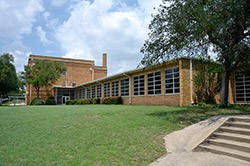
Photo courtesy of Historic Fort Worth, Inc.
The newest Transition Center building was designed by Wyatt C. Hedrick, Sanguinet & Staats successor, and built by Charles H. Haws in 1954 to connect the two older buildings and add 6 classrooms. The entire complex became an elementary school. In recent years, this collection of buildings has become a school for students with learning differences for grades 1 through 12 and was renamed Boulevard Heights Transition Center. The citizens of Fort Worth and the FWISD would be well-served if Boulevard Heights Transition Center were designated as an Historic & Cultural Landmark of the City of Fort Worth and placed on the National Register of Historic Places.
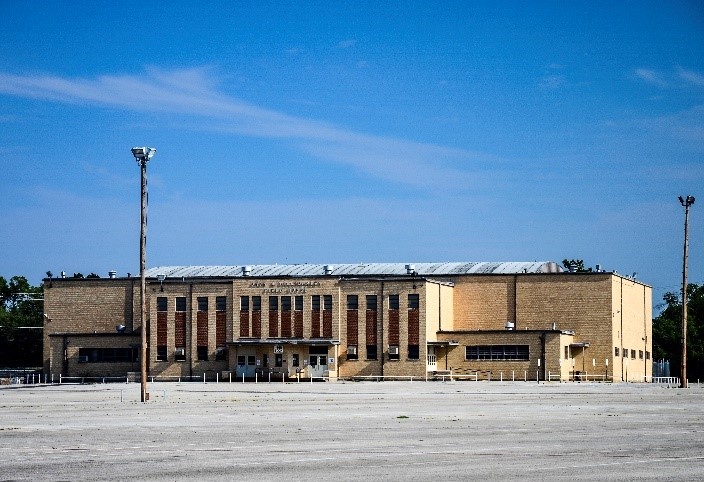
Photo courtesy of Historic Fort Worth, Inc.
Jack A. Billingsley Field House (originally, Fort Worth Field House)
Address: 1400 Foch Street
For basketball, volleyball and wrestling
Date built: 1953
Designed by Preston M. Geren, Sr. and constructed in 1953, the Field House was renamed Jack A. Billingsley Field House in the early 1980’s in tribute to the FWISD’s coach, principal, athletic director, and assistant superintendent’s impactful 39-year career.
It is a single-storied building though it has the appearance of being two. The roof, mostly concealed by a parapet, is slightly barrel pitched, and the windows are metal. The three-sided ticket booth’s ticket counter is at the top of two concrete stairs, and metal stanchions are in front of each window.
The interior retains a great deal of its integrity with its original concrete bleachers with wood-plank seats, a phone booth with a wood door, and dressing rooms with their original wood benches and wood clothes cubby.
The interior walls are constructed of concrete block and in many areas the lower portion of the walls is are covered with glazed tiles. The lobby floor is terrazzo.
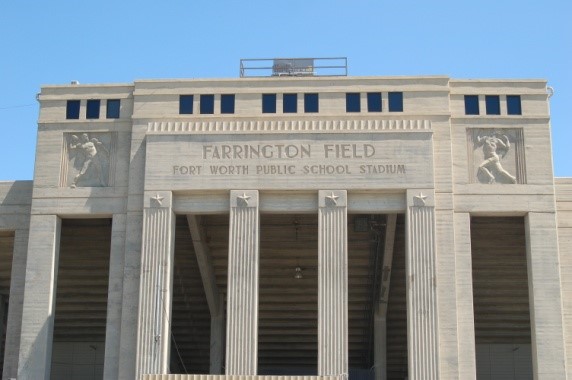
Photo courtesy of Historic Fort Worth, Inc.
Historic Fort Worth, Inc. is dedicated to preserving Fort Worth’s unique historic identity through stewardship, education and leadership.
John T. Roberts, AIA, former board chairman and current chairman of HFW’s Public Affairs Committee, is the author.



 Sign in
Sign in


Farrington Field is named for my grandfather, Evan Stanley Farrington Sr. My father, Stanley Farrington (Evan S. Farrington Jr.) kicked the first football in the stadium in 1939. I am in possession of all the history and photos surrounding the Field and would love to collaborate with you to educate Fort Worth about its significance and uniqueness in hopes of saving it, if worthy, from destruction by the FWISD. Evan
Hello,
I am a TCU journalism student and graduated from Arlington Heights High School. I am doing a story on the preservation of Farrington Field and would love to set up interview with anyone who is interested in this topic. Please email me at lucy.puente@tcu.edu if you are interested.